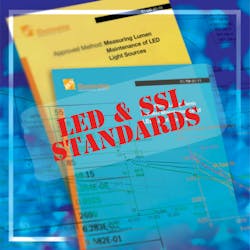The Illuminating Engineering Society (IES) and the International Ultraviolet Association (IUVA) have announced a collaboration that will yield standardization of lighting measurement (LM) methodologies for both LED and conventional-lamp sources that are specifically targeted at disinfection. The initiative will focus on UV-C-band (100–280-nm) LEDs and lamps that right now are surging in interest relative to the ability of that UV-C energy to deactivate the coronavirus. The separate LED and lamp projects will yield ANSI (American National Standards Institute) standards by the end of this year with the partners planning for more supporting standards in 2021 and beyond.
The ability of UV-C radiation to deactivate viruses and other pathogens has been studied sporadically for more than a century. We hosted a webcast on the topic recently, and the speaker Bob Karlicek, director of the Center for Lighting Enabled Systems & Applications (LESA) at Rensselaer Polytechnic Institute, covered some of the history and noted that interest wanes somewhat when pandemics pass. We have written quite a lot about UV-C disinfection of water and air using LEDs and there are products in the market even at the consumer kitchen-faucet level.
Moreover, both UV-C in immediate disinfection and UV-A, or short-wavelength 405-nm violet light, in continuous disinfection applications have been widely discussed as tools than can battle healthcare associated infections (HAIs). Still, it’s the coronavirus pandemic that has raised the UV-C interest level to all-time highs.
The initial LM standards being pursued will guide manufacturers in characterizing and publishing specifications on UV-C sources and will allow product developers to more easily evaluate competing sources. “The Illuminating Engineering Society is dedicated to developing standards and providing educational content on UV-C to help reduce the number of healthcare-associated infections and the transmission of pathogens, such as the SARS-CoV-2 virus,” said Brian Liebel, IES director of standards and research. Working with the International Ultraviolet Association, we feel confident that our organizations can effectively deliver much-needed measurement and testing standards to evaluate new products as they come to market.”
As mentioned earlier, one of the new standards will focus on UV-C LEDs. Think of it as analogous to the LM-80 standard for characterizing visible-light LEDs. The second standard will focus on characterization of low-pressure mercury and xenon lamps.
The timeframe for development of the standards is tight, but the need for speed is clearly evident. “The standardization work is being undertaken by a task group formed within the IES Testing Procedures Committee,” said Alex Baker, manager of government affairs and public policy at the IES. “The task group’s drafts will be balloted within the committee. Following any necessary revisions and the ANSI public comment period, IES hopes to publish the first two ANSI/IES/IUVA standards by year’s end. Additional UV measurement standards are envisioned in 2021.”
The IES found a natural collaboration partner in the IUVA. “IUVA, through its Healthcare/UV Working Group, has been working on developing industry consensus-based standards for UV disinfection since 2018,” said Troy Cowan, the IUVA working group’s coordinator. “Establishing this partnership with IES is a key component of making that happen. We needed representation of the entire lighting sector to build industry-consensus, and IES delivers that. Thanks to IES’ and IUVA’s collaborative efforts, these new ANSI standards will eliminate much of the ambiguity and uncertainty in UV output measurement. This will improve accuracy and quality, and give the healthcare industry a credible basis for assessing output of UV disinfection devices for the first time.”
For up-to-the-minute LED and SSL updates, why not follow us on Twitter? You’ll find curated content and commentary, as well as information on industry events, webcasts, and surveys on our LinkedIn Company Page and our Facebook page.





